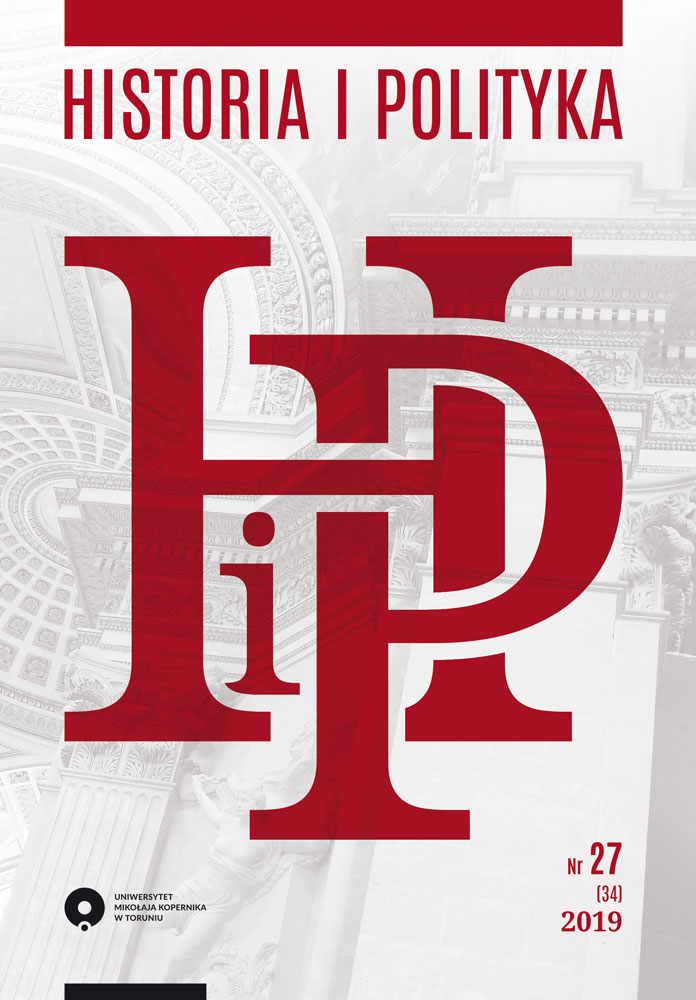Stany Zjednoczone a integracja polityczna, militarna i gospodarcza Europy Zachodniej w pierwszych latach po II wojnie światowej (do 1950 r.). Ameryka nadaje ton i dyktuje warunki (Część I)
DOI:
https://doi.org/10.12775/HiP.2019.006Słowa kluczowe
Second World War, post-war period, Western Europe, United States, political, military and economic integration, the doctrine of isolationism, Western European organizations, economic development, international trade, loans and credits, Marshall PlanAbstrakt
The influence of the US on the forms and course of the integration processes in Western Europe was very strong, especially in the first post-war years. It was the influence of an external force which, being free of the internal contradictions stemming from Western Europe’s interests, had at its disposal real capabilities to impose integration concepts beneficial to itself. Such integration was in line with both the economic and military interests of the United States during this period. The main reasons prompting Western European countries in the first post-war years to accept the solutions suggested by the United States were: the said countries’ difficult economic situation, fear of the communist parties’ coming to power, and the reluctant (hostile) attitude towards the USSR and the communist bloc. The combination of these causes served to temporarily neutralize the centrifugal tendencies and muted the divergence of interests between the individual countries of Western Europe. Such motives of integration also influenced the character of the emerging Western European political, military and economic organizations. The economic development of Western European countries, whose sources, in addition to the Marshall Plan, should be seen also in other factors, later led to a shift of integration initiatives from the American side to the European one. From a formal point of view, the effects of US policy in the period up to 1950 entailed: the establishment of NATO, the creation of the OEEC and the signing of the agreement on the EUP.
Bibliografia
Beloff, M. (1963). The United States and the Unity of Europe. London.
Bulletin. (1950). Department of State. 17 September.
Bulletin. (1954). Department of State. 27 September.
Camps, M. (1957). Trade Policy and American Leadership. New York: Princeton University.
Economic Survey of Europe in 1961, Part 2: Some Factors in Economic Growth in Europe during the 1950. (1962). Geneva.
Ellsworth, P.T. (1958). The International Economy. New York: McMillan Company.
Feld, W. (1968). The European Common Market and the World. New Jersey.
Ferrell, R.H. (1996). The Truman Era and European Integration. W: F.H. Heller, J.R. Gillingham, The United States and the Integration of Europe. New York: St. Martin’s Press.
Fisher, A.G.B. (1945). Economic Progress and Social Security. London: Macmillan & Co. Ltd.
Harper, J.L. (1994). American Visions of Europe. Cambridge: Cambridge University Press.
Interim Report on the European Recovery Programme. (1948). Paris: OEEC.
Kamecki, Z., Sołdaczuk, J., Sierpiński, W. (1964). Międzynarodowe Stosunki Ekonomiczne. Warszawa: Państwowe Wydawnictwo Ekonomiczne.
Kwilecki, A. (1969). Idea zjednoczenia Europy. Poznań: Wydawnictwo Poznańskie.
Lundestad, G. (1998). „Empire” by Integration. The United States and European Integra¬tion, 1945–1997. Oxford: Oxford University Press.
Łychowski, T. (1954). Zagadnienia obrotu międzynarodowego. Warszawa: PWN.
Milward, A.S. (1984). The Reconstruction of Western Europe 1945–1951. Berkeley: University of California Press.
Morawiecki, W. (1970). Międzynarodowe Organizacje Gospodarcze. Warszawa: SGPiS.
Morison, E.S. (1928). The Oxford History of the United States 1783–1917. Oxford: Oxford University Press.
Nowak, A. (1965). Koncepcje integracji Europy Zachodniej na tle procesów rozwoju ekonomicznego. Poznań: Instytut Zachodni.
Nowak, Z. (1965). Niemiecka Republika Federalna a integracja ekonomiczna Europy Zachodniej. Przegląd Zachodni, 1.114
Spanier, J.W. (1960). American Foreign Policy since World War II. New York: Praeger.
Stebbins, R.P. (1950). The U.S. in World Affairs 1949–1950. New York: Harper&Brothers.
Truman, H.S. (1956). Years of Trial and Hope 1946–1953. London: Holder and Stoughton.
Urwin, D.W. (1995). The Community of Europe. A History of European Integration since 1945. London – New York: Longman.
Van der Beugel, E.W. (1966). From Marshall Plan to Atlantic Partnership. New York: American Elsevier.
Wandycz, P., Frendl, L. (1965). Zjednoczona Europa. Teoria i praktyka. Londyn: Polonia Book Fund.
Werner, A. (1966). Wielka próba sił USA–EWG–NRF. Warszawa: Zachodnia Agencja Prasowa.
Z zagadnień dojrzewania kryzysu gospodarczego w USA. Praca zbiorowa. (1954). Ekonomista, 3.
Zdziechowski, J. (1952). Główne zagadnienia ekonomii, gospodarcza i polityczna analiza planu Schumana. Londyn.
Pobrania
Opublikowane
Jak cytować
Numer
Dział
Licencja
Uniwersytet Mikołaja Kopernika w Toruniu respektuje prawo do prywatności i ochrony danych osobowych autorów.
Dane autorów nie są wykorzystywane w celach handlowych i marketingowych. Redaktorzy i recenzenci są zobowiązani do zachowania w poufności wszelkich informacji związanych ze złożonymi do redakcji tekstami.
Autor, zgłaszając swój tekst wyraża zgodę na wszystkie warunki i zapisy umowy licencyjnej (określającej prawa autorskie) z Uniwersytetem Mikołaja Kopernika w Toruniu.
Statystyki
Liczba wyświetleń i pobrań: 433
Liczba cytowań: 0



